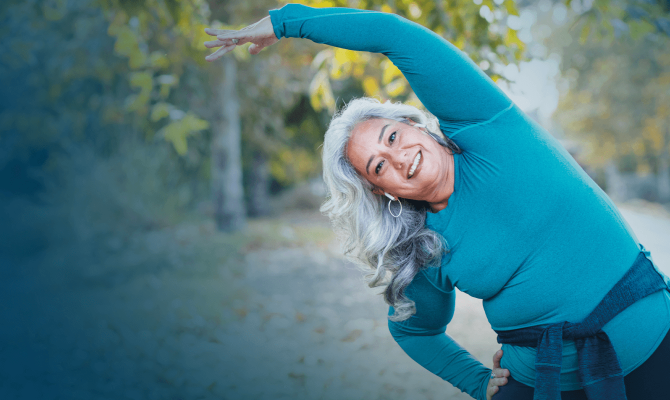Staying fit and active as we get older
4 Oct 2022

However, as we age, we lose strength, flexibility, and the ability to regenerate as quickly as we did before. While this is a normal, natural part of getting older, there are things we can do to avoid unnecessary injuries and improve our day-to-day physical health.
You’ve likely heard it a thousand times, but getting into a good habit of regular physical activity will pay off incredibly well in the long run. Even a small amount of daily movement and focusing on a less sedentary lifestyle during your thirties, forties, and fifties will be hugely beneficial in the golden years. But what does this look like?
1. Start lightly, and listen to your body.
Day one might mean a short walk around the block, and doing a couple of sets of light dumbbell presses. Day two might mean another short walk, and adding a couple more sets of presses. While some of us might be tempted to launch full-throttle at an exercise regime, the best advice is usually to start slow – like, really slow – and build up from there. The high-impact tennis court or sweaty weights room will still be there in a few weeks or months, but a nasty tweak could take you off-course for weeks – talk about a hit to the motivation!
A good step is to check in with your GP, and/or physio if you have one, and perhaps book a session or two with a personal trainer to start you off. That way you can discuss with your healthcare professional what might be within – and outside – your reach, at least to begin with. A personal trainer can help you devise a routine which limits the risk of injury, and set you up with a programme that’s achievable, fun, and helps you to live pain and discomfort-free. Further, they’ll be able to give you recommended warm-up and warm-down exercises – which are absolutely crucial to avoiding strains. Forget these at your own peril!
2. Strength training – seriously
Strength training is one of – if not the most effective ways to improve your fitness and overall health. This is because as we get older, our bodies start to lose strength, flexibility, and bone mass, and we have to work a bit harder to maintain our fitness. Strength and resistance training helps us build up muscle with repetitive motion – using weights or resistance from machines, bands, or your own bodyweight. Building a bit of muscle means better movement, more stability, and better functional strength – things like getting in and out of cars, opening jars, and carrying heavier objects.
What can this look like? Many experts believe starting with your bodyweight – or if using weights, low-weight dumbbells – is the best way to kickstart a strength training regimen. Starting light means getting comfortable with using good form before progressing to heavier weights, where there’s more risk of injury. One of our most commonly-asked questions from older people is: how do I build core strength gently and at home? While there are plenty of Youtube videos with useful info, often simple is best. Forget sit-ups and crunches – they put unnecessary strain on your back. Instead, try simple variations of just three movements: planks, bridges, and arm/leg raises. Google them and give them a go. Doing ten minutes of core strength exercises 4-6 times a week will do wonders for your mobility as you get older.
3. Staying motivated is the entire battle
While much fuss is made over dialling in the perfect exercise routine, committing to the perfect diet, and making sure you’re maximising your results – this all-or-nothing approach can wreak havoc on your motivation and real-life outcomes.
Exercise is easy to make complicated. When your routine is complicated or too difficult to easily understand, keeping consistent becomes much, much more difficult. That’s why working with a personal trainer to build a short, simple programme (for example: think four exercises, four sets of ten repetitions, four times a week, or similar) is so important. If you commit and stay consistent, you’ll see and feel the difference – and that’s what’ll motivate you to go for even bigger goals via a more complicated programme. But for now … KISS! (Keep it simple, stupid!)
One of the best ways to stay motivated and consistent is to link up with an exercise buddy – bringing along a friend, family member, partner, or join a community fitness group. It can be really difficult to motivate yourself if you feel like you’re going at it alone, so we highly recommend finding a person to talk and check in with, to discuss goals or progress and build a positive relationship with fitness together. Further, focus on short-term, achievable goals (which aren’t focused on weight loss), like ‘improve mood and energy levels in four weeks’ time’ or ‘in October, work up to jogging for 1km’. These types of goals are positive, more holistic, and support you to keep moving forward, highlighting your strengths and the hard work you’ve put in.
If you’re looking to speak with an expert about kicking off or progressing your fitness journey as an older person, don’t hesitate to get in touch with Habit Health’s team of highly trained personal trainers. Also, if you have a long standing injury or limitation when it comes to exercise, our physiotherapist can assess your function and guide you on a path to physical fitness and improved function.